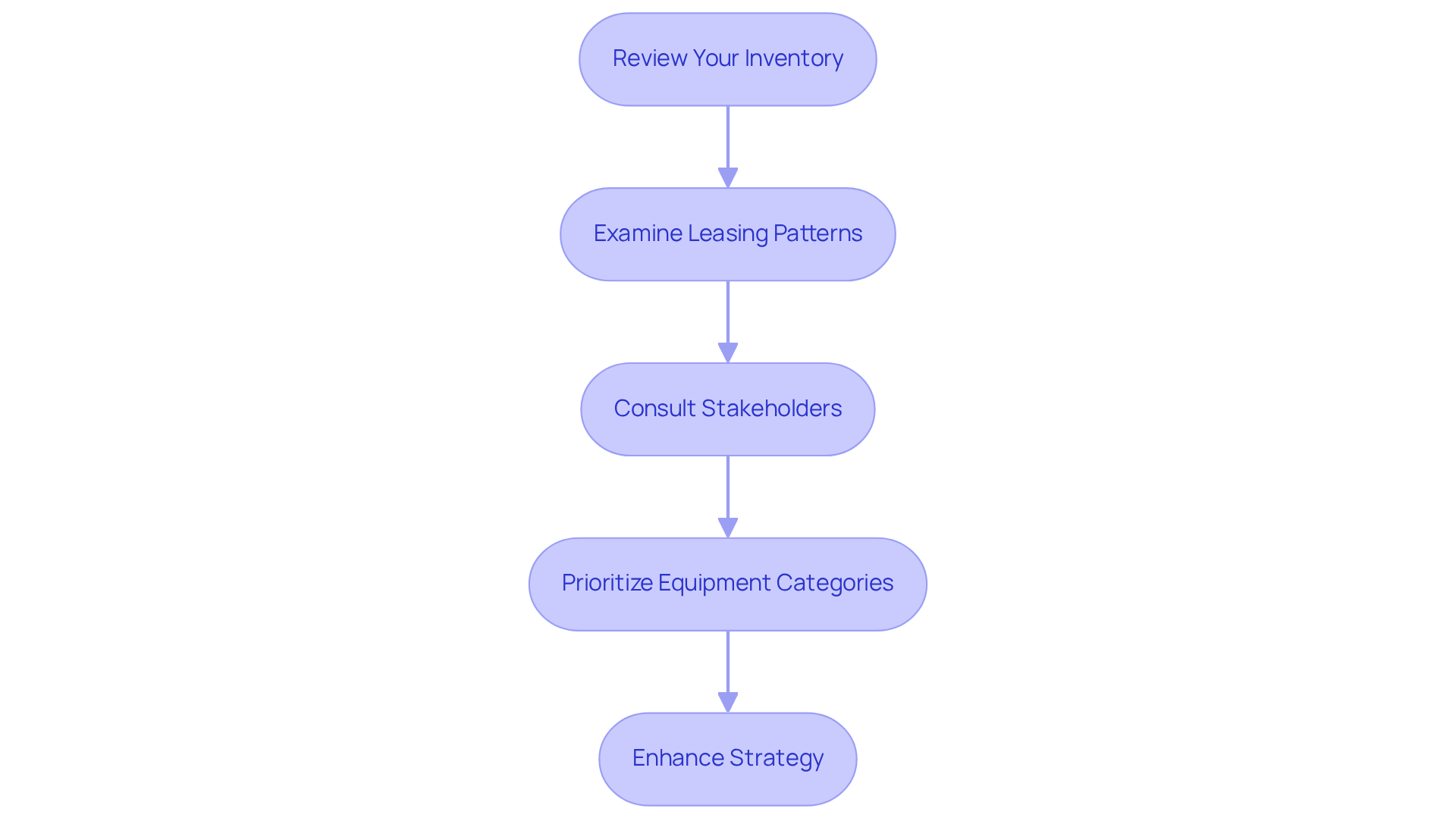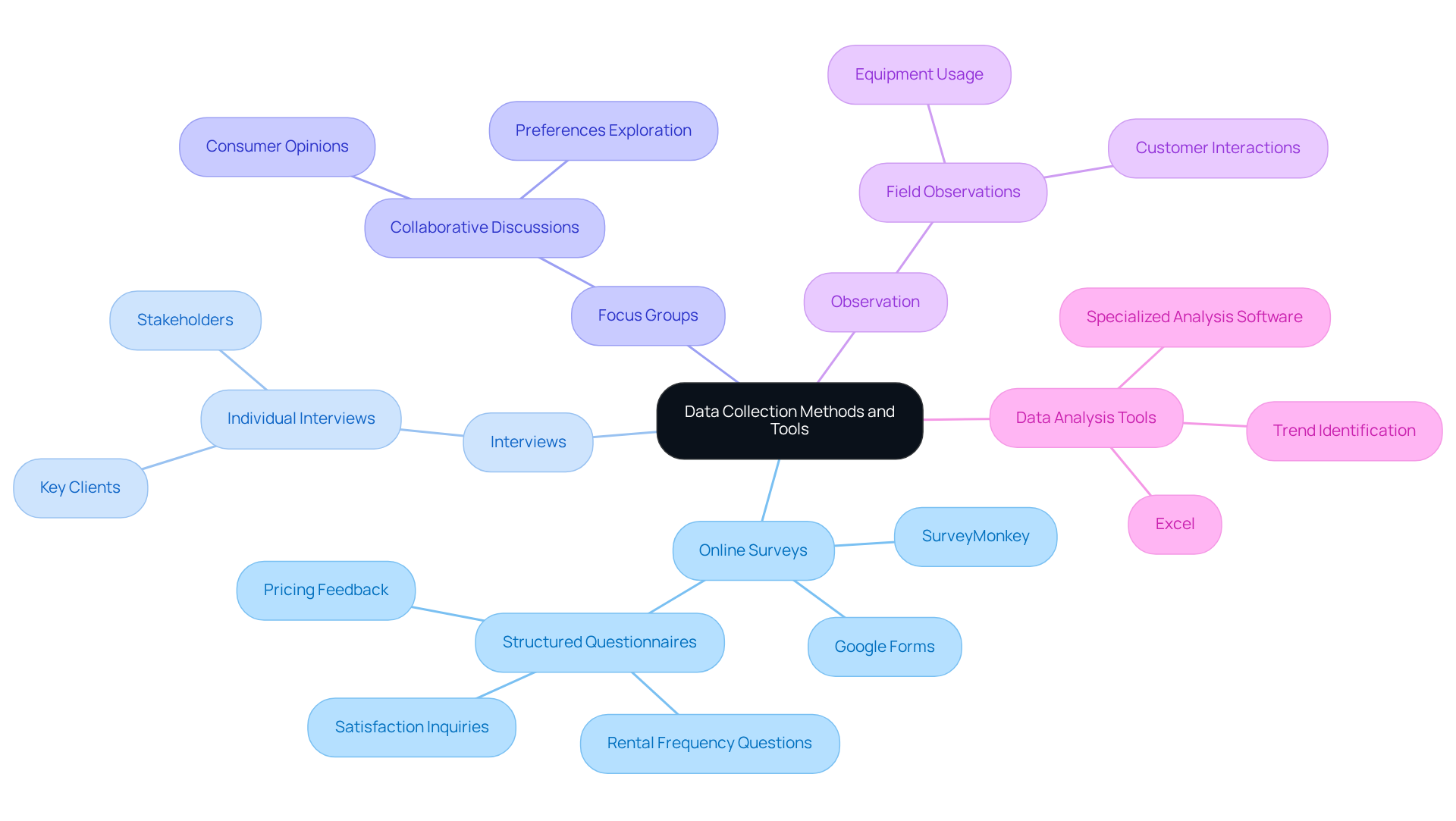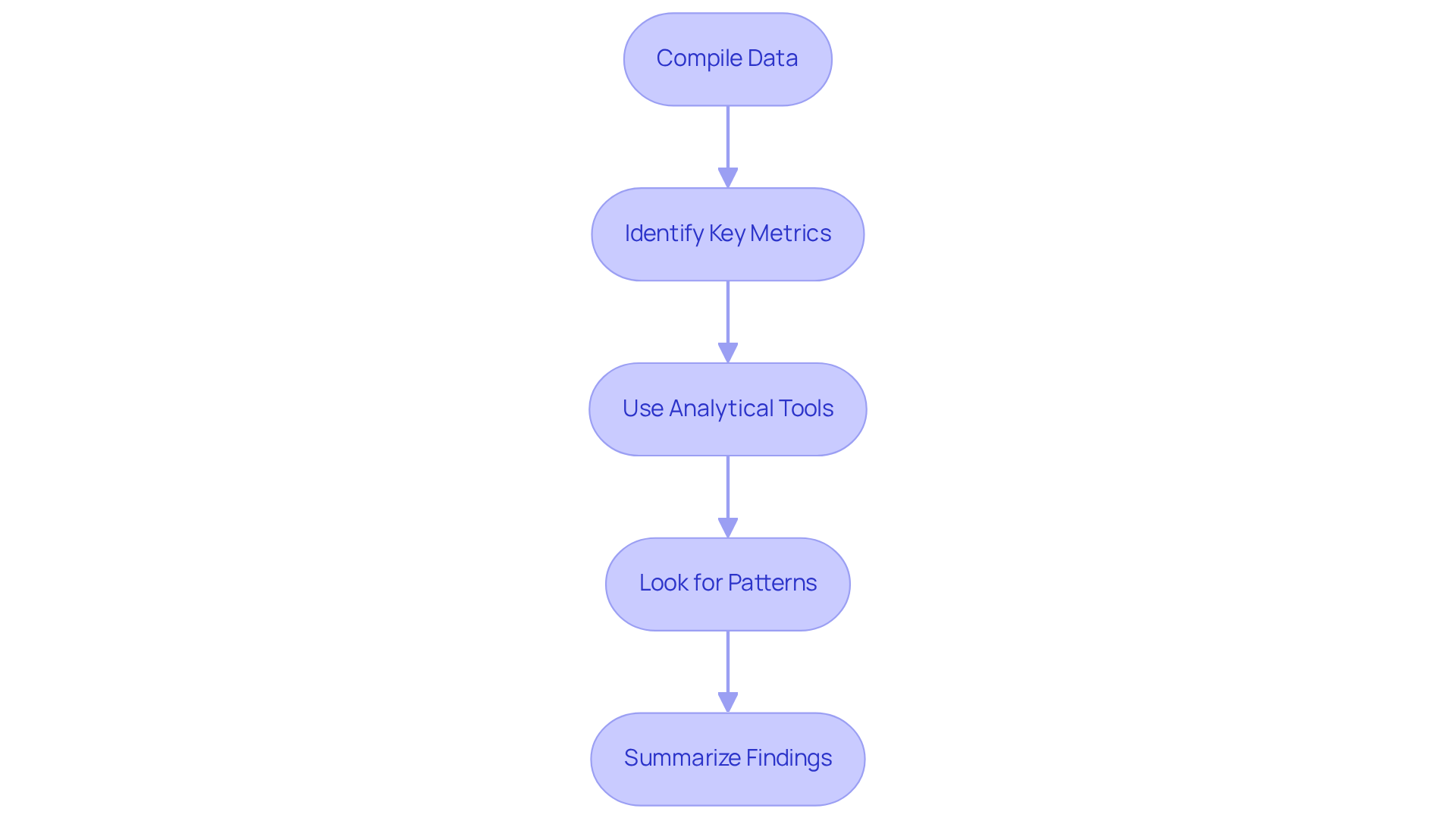Overview
This article delineates five essential steps for executing an effective survey on rental equipment. It emphasizes the significance of:
- Defining clear objectives
- Selecting suitable data collection methods
- Analyzing the gathered data for actionable insights
By adhering to these steps, organizations can align their inventory and services with client needs, thereby enhancing customer satisfaction and maintaining a competitive edge in the equipment rental market.
Key Highlights:
- Define specific objectives for the equipment survey, ensuring they are SMART (Specific, Measurable, Achievable, Relevant, Time-bound).
- Identify key questions to gather insights on client satisfaction, device performance, and leasing trends.
- Review inventory to understand available tools and analyse leasing patterns for informed decision-making.
- Engage stakeholders to gather insights on equipment needs and preferences.
- Select effective data collection methods such as online surveys, interviews, focus groups, and field observations.
- Compile and analyse survey data to identify key metrics, trends, and patterns related to client satisfaction and equipment usage.
- Develop an action plan based on survey findings to optimise equipment rental choices and enhance client satisfaction.
- Communicate changes to stakeholders, monitor results, and solicit ongoing feedback to ensure alignment with client needs.
- Adjust strategies as necessary to maintain competitiveness in the equipment rental industry.
Introduction
Understanding the dynamics of rental equipment is essential for businesses seeking to optimize their offerings and enhance customer satisfaction. A well-structured survey can unveil valuable insights into client preferences, equipment performance, and market trends. However, the challenge lies in effectively designing and implementing this survey to ensure it yields actionable data. What are the essential steps to conduct a survey that not only meets business objectives but also resonates with client needs?
Define the Objectives of Your Equipment Survey
Begin by outlining the specific objectives of your assessment. Identify the crucial details necessary for the collection of information on survey rental equipment, such as client satisfaction, device performance, or leasing trends. For instance, you may aim to understand the frequency of specific item borrowings or recognize client preferences. Ensure your objectives are SMART—Specific, Measurable, Achievable, Relevant, and Time-bound—facilitating effective data collection and analysis.
- Identify Key Questions: What insights do you seek? For example, are you interested in client feedback regarding product quality or pricing for rentals?
- Set Measurable Targets: Define how success will be measured. For instance, aim for a 20% increase in customer satisfaction ratings based on feedback results.
- Align with Business Goals: Ensure your objectives support broader business strategies, such as enhancing rental rates or increasing your inventory of tools.
- Document Your Objectives: Clearly write down your objectives for reference throughout the evaluation process.
Statistics reveal that 84% of construction firms in the U.S. prefer leasing tools over purchasing, highlighting the importance of a survey on rental equipment to understand client requirements and preferences in your research goals. By establishing clear and quantifiable objectives, you can enhance the efficiency of your tool leasing assessments and achieve superior business results.

Identify the Types of Equipment to Include
To effectively conduct a survey rental equipment, it is crucial to start by identifying the types of items to include. Start with these essential steps:
-
Review Your Inventory: Evaluate the variety of tools currently available for rent at EZ Equipment Rental, which includes air compressors, boom lifts, forklifts, and generators. This foundational step ensures you have a comprehensive understanding of your offerings, tailored to meet the diverse needs of clients in the DFW Metroplex.
-
Examine Leasing Patterns: Analyze historical lease data to pinpoint which tools are most frequently borrowed and exhibit the highest demand from clients. This analysis is vital, as the rental market for tools is projected to expand significantly, with a compound annual growth rate (CAGR) of 6.8% from 2026 to 2032. Understanding these trends will guide your inventory decisions and enhance service offerings.
-
Consult Stakeholders: Engage with your team and clients to gather insights into their equipment requirements and preferences. This collaborative approach can reveal critical information regarding what should be prioritized in your assessment, ensuring alignment with market demands.
-
Prioritize Equipment Categories: Focus on tools that are essential for your business operations and that enhance client satisfaction. For instance, if landscaping tools show a notable increase in demand, they should be prominently featured in your survey. This targeted strategy not only addresses client needs but also positions your leasing enterprise for success in a competitive market. Notably, recent data indicates that 47% of leasing firms reported providing more tools to contractors compared to the previous year, reflecting an increasing reliance on leasing services.
By following these steps, you can ensure that your questionnaire effectively captures the necessary data to inform your equipment rental strategy, reinforcing EZ Equipment Rental's commitment to reliability and exceptional customer service.

Select Data Collection Methods and Tools
Select the methods and tools that will effectively gather data for your questionnaire. Consider the following options:
-
To effectively survey rental equipment, leverage online survey platforms such as SurveyMonkey or Google Forms to develop structured questionnaires. These should include inquiries about satisfaction with tools, rental frequency, and pricing related to survey rental equipment.
-
Interviews: Engage in individual interviews with key clients or stakeholders to obtain in-depth feedback regarding their experiences with your tools.
-
Focus Groups: Organize focus group discussions to explore consumer opinions and preferences in a collaborative environment, fostering richer insights.
-
Observation: Conduct field observations of equipment usage to collect qualitative data on performance and customer interactions, providing a real-world perspective.
-
Data Analysis Tools: Utilize data analysis software to interpret the gathered data effectively. Tools like Excel or specialized analysis software can assist in identifying trends and insights, enhancing your decision-making process.
By employing these methods, you can ensure a comprehensive understanding of your clients' needs and preferences, ultimately driving better service and satisfaction.

Analyze Survey Data for Insights and Trends
Once data collection is complete, analyzing the results is crucial for deriving actionable insights. Follow these steps:
- Compile Data: Gather all survey responses and organize them in a manageable format, such as a spreadsheet, to facilitate analysis.
- Identify Key Metrics: Concentrate on metrics that correspond with your objectives, including customer satisfaction scores, utilization rates—which can average around 70% in leasing businesses—and frequency of rentals for survey rental equipment. Monitoring maintenance costs is also essential, as it serves as a key performance indicator (KPI) that directly impacts profitability and operational efficiency, similar to the way we survey rental equipment.
- Use analytical tools to effectively visualize trends in survey rental equipment by employing advanced data analysis tools and rental management software. These tools can automate the analysis process, allowing for real-time tracking of device performance and enhancing decision-making.
- Look for Patterns: Analyze the data for recurring themes. For example, if several clients show discontent with a particular item, this may suggest a requirement for upkeep or substitution. Incorporating GPS or RFID technology can also assist in monitoring asset usage and ensuring prompt maintenance, which is essential for reducing downtime.
- Summarize Findings: Create a summary report that highlights key insights and trends, making it easier to communicate findings to stakeholders. This report should include actionable recommendations based on the data analysis, ensuring that decisions are informed by reliable metrics. Furthermore, consider including insights from customer feedback questionnaires to obtain a deeper comprehension of customer satisfaction and equipment performance.

Implement Findings to Optimize Equipment Rental Choices
To effectively implement the insights gained from your survey analysis, follow these steps:
-
Develop an Action Plan: Formulate a comprehensive plan that addresses the survey findings. For instance, if the data reveals a preference for specific equipment types, consider how to survey rental equipment to expand your inventory accordingly and satisfy client demand. Remember, 71% of clients make purchase decisions based on the quality of service, underscoring the necessity of aligning your offerings with client preferences.
-
Communicate Changes: Clearly inform your team and stakeholders about the changes being made in response to the survey feedback. This transparency fosters a culture of responsiveness and continuous improvement within your organization. As Ana Miljkovic states, "Make the client the hero of your narrative," emphasizing the significance of prioritizing client needs.
-
Monitor Results: After implementing the changes, consistently track their effect on client satisfaction and leasing rates. Utilize key performance indicators (KPIs) to measure success and identify areas for further enhancement. Case studies indicate that a 1% reduction in missed income can boost net profits by 2-3%, highlighting the financial benefits of effective monitoring.
-
Solicit ongoing feedback by establishing a routine to survey rental equipment and gather client feedback, ensuring that your offerings remain aligned with their evolving needs. Regular feedback loops can significantly enhance client loyalty and satisfaction. Statistics show that 83% of customers are loyal to brands that provide great customer service, reinforcing the need for continuous engagement.
-
Adjust Strategies as Needed: Stay flexible and ready to adapt your strategies based on ongoing feedback and market trends. This adaptability is crucial for maintaining a competitive edge in the equipment rental industry and ensuring that your business remains customer-focused.

Conclusion
Conducting an effective survey for rental equipment is crucial for understanding client needs and preferences, ultimately leading to improved service and satisfaction. By following the outlined steps—defining clear objectives, identifying key equipment types, selecting appropriate data collection methods, analyzing the gathered data, and implementing findings—businesses can significantly enhance their rental strategies. This structured approach not only aligns with client expectations but also supports broader business goals.
The article underscores the necessity of establishing SMART objectives to guide the survey process, ensuring that the data collected is both relevant and actionable. Key insights from the survey can drive inventory decisions, inform service offerings, and foster a culture of continuous improvement. Furthermore, utilizing various data collection methods, such as online platforms and interviews, enables a comprehensive understanding of client experiences and preferences.
Ultimately, the importance of conducting regular surveys cannot be overstated. By continuously engaging with clients and adapting strategies based on their feedback, businesses can maintain a competitive edge in the equipment rental market. Embracing this proactive approach not only boosts client loyalty but also enhances overall profitability, making it imperative for rental companies to prioritize effective survey practices.
Frequently Asked Questions
What are the objectives of an equipment survey?
The objectives of an equipment survey should include collecting information on client satisfaction, device performance, and leasing trends. They should be SMART—Specific, Measurable, Achievable, Relevant, and Time-bound—to facilitate effective data collection and analysis.
How can I set measurable targets for my equipment survey?
Measurable targets can be set by defining specific metrics for success. For example, you might aim for a 20% increase in customer satisfaction ratings based on feedback results.
Why is it important to align survey objectives with business goals?
Aligning survey objectives with broader business strategies ensures that the assessment supports key goals, such as enhancing rental rates or increasing inventory, ultimately leading to improved business outcomes.
What types of equipment should be included in the survey?
The survey should include a variety of tools available for rent, such as air compressors, boom lifts, forklifts, and generators, based on an evaluation of the current inventory and client needs.
How can I analyze leasing patterns for my survey?
Analyze historical lease data to identify which tools are most frequently borrowed and in high demand. This analysis helps guide inventory decisions and enhances service offerings.
What role do stakeholders play in identifying equipment needs?
Engaging with team members and clients can provide valuable insights into their equipment requirements and preferences, ensuring that the survey reflects market demands.
How can prioritizing equipment categories benefit my survey?
By focusing on tools essential for business operations and those that enhance client satisfaction, you can ensure the survey addresses client needs and positions your leasing enterprise for success in a competitive market.
What recent trends indicate the importance of rental equipment surveys?
Statistics show that 84% of construction firms in the U.S. prefer leasing tools over purchasing, and 47% of leasing firms reported providing more tools to contractors compared to the previous year, highlighting the growing reliance on leasing services.




